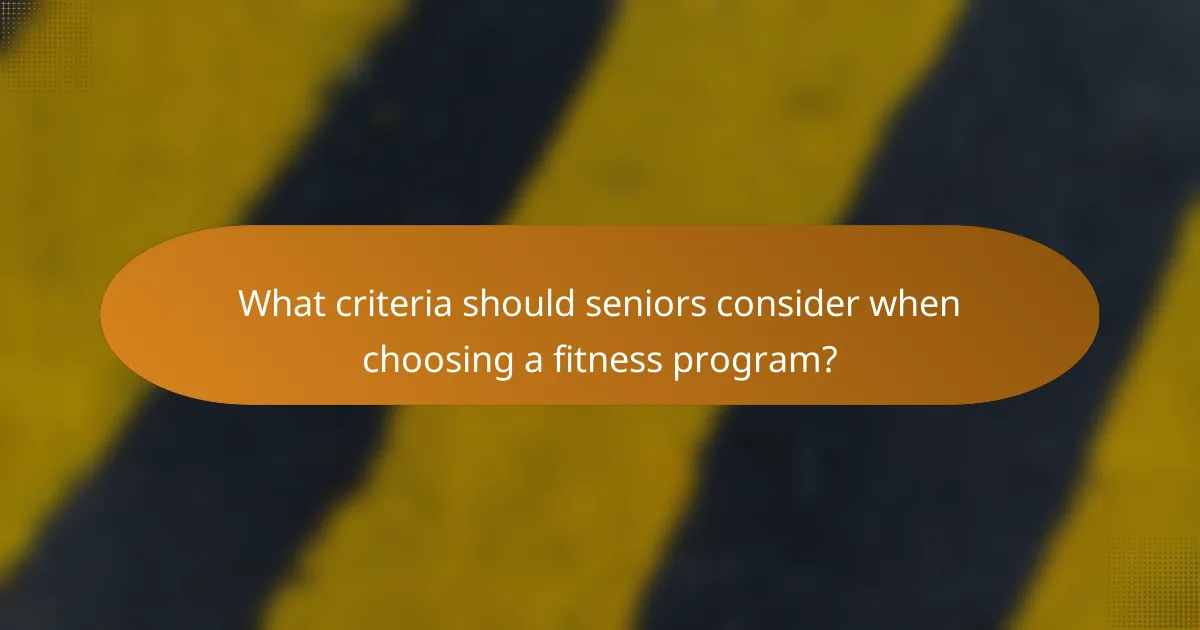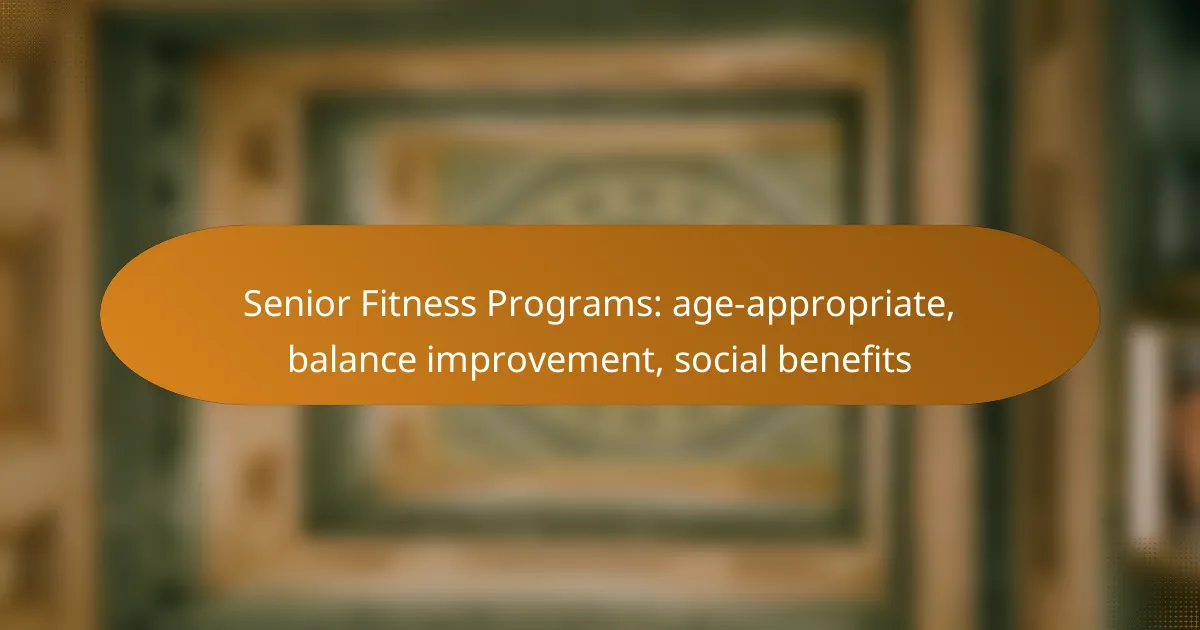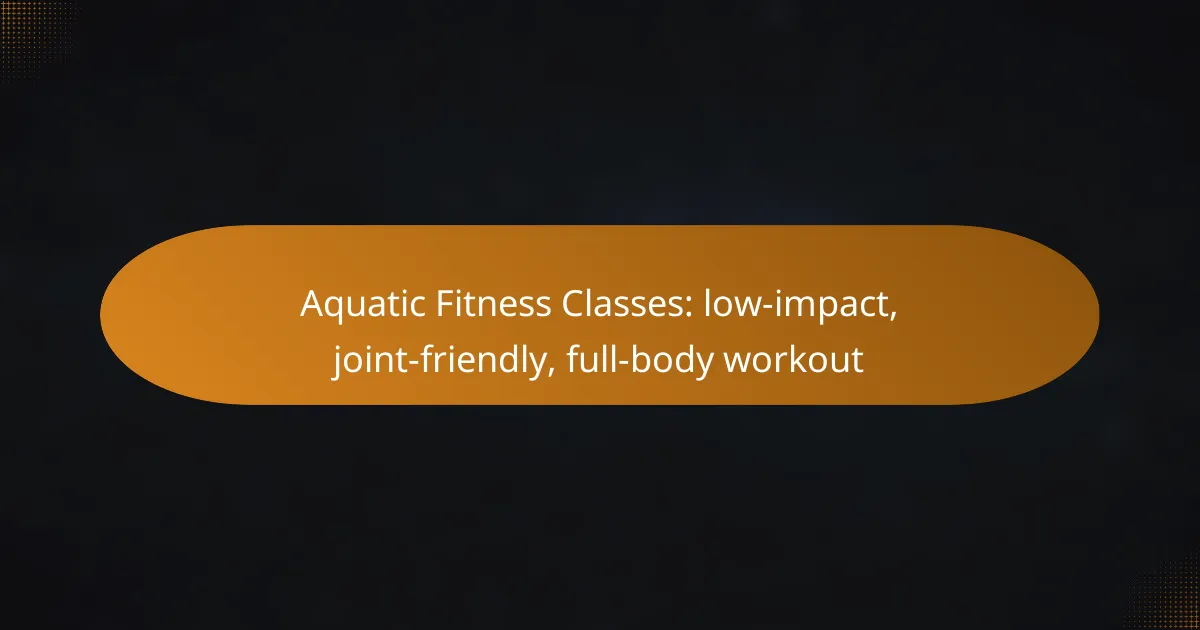Senior fitness programs are designed to meet the unique needs of older adults, focusing on age-appropriate exercises that enhance balance, coordination, and strength. These programs not only prioritize safety but also foster social connections, helping participants build friendships and support networks that contribute to their emotional well-being.

What are the best senior fitness programs for balance improvement?
The best senior fitness programs for balance improvement focus on enhancing stability, coordination, and strength through tailored exercises. These programs often include group classes and activities that promote social interaction while addressing the specific needs of older adults.
SilverSneakers program
SilverSneakers is a widely recognized fitness program designed specifically for seniors, offering access to gym facilities and specialized classes. Participants can engage in activities that enhance balance, strength, and flexibility, often at no additional cost through Medicare or other health plans.
Classes typically include low-impact aerobics, strength training, and stretching exercises. Many locations also provide social events, fostering a sense of community among participants.
EnhanceFitness classes
EnhanceFitness classes are evidence-based programs aimed at improving balance and overall fitness for older adults. These classes focus on low-impact aerobic exercises, strength training, and flexibility, all tailored to the abilities of participants.
Classes are usually held in community centers or senior living facilities, making them accessible. Participants can expect to see improvements in their balance and mobility over time, contributing to a more active lifestyle.
Tai Chi for Seniors
Tai Chi for Seniors is a gentle martial art that emphasizes slow, controlled movements to enhance balance and coordination. This practice is particularly beneficial for seniors as it promotes relaxation and mindfulness while improving physical stability.
Classes are often available in community centers and parks, making them easy to access. Regular practice can lead to significant improvements in balance and a reduction in fall risk.
Chair Yoga sessions
Chair Yoga sessions are designed for seniors with limited mobility, allowing them to practice yoga while seated. This approach helps improve flexibility, strength, and balance without the need for getting on the floor.
These sessions often include breathing exercises and gentle stretches, making them suitable for all fitness levels. Many community centers and senior facilities offer chair yoga classes, providing a supportive environment for participants.
Balance and Stability workshops
Balance and Stability workshops are specialized programs that focus on exercises designed to enhance core strength and stability. These workshops often include a mix of strength training, balance exercises, and fall prevention strategies.
Participants can expect to engage in activities such as standing on one leg or using balance boards. These workshops are typically offered at local gyms or community centers, providing valuable skills to help seniors maintain their independence and reduce fall risk.

How do senior fitness programs enhance social benefits?
Senior fitness programs significantly enhance social benefits by fostering connections among participants, reducing feelings of isolation, and promoting a sense of community. Engaging in physical activities together helps seniors build friendships and support networks, which are vital for emotional well-being.
Group exercise classes
Group exercise classes provide a structured environment where seniors can work out together, encouraging camaraderie and motivation. These classes often include activities like yoga, water aerobics, or dance, which not only improve physical health but also create opportunities for social interaction.
When choosing a class, look for those specifically designed for older adults, as they typically focus on balance, flexibility, and strength. Many community centers and gyms offer these classes at affordable rates, often subsidized by local health initiatives.
Community fitness events
Community fitness events, such as charity walks or local sports days, allow seniors to participate in physical activities while engaging with their neighbors. These events often promote health awareness and provide a platform for socializing, making them an excellent way to connect with others.
Consider participating in events that cater to various fitness levels, ensuring that everyone can join in. Check local community boards or senior centers for upcoming events, which are often free or low-cost.
Online fitness communities
Online fitness communities offer seniors a chance to connect with others interested in health and wellness from the comfort of their homes. These platforms can include social media groups, forums, or dedicated fitness apps where members share tips, progress, and encouragement.
When joining an online community, look for those that focus on senior fitness to ensure the content is relevant and supportive. Engaging in discussions and sharing experiences can help build a sense of belonging, even when physical gatherings are not possible.

What are the key features of age-appropriate fitness programs?
Age-appropriate fitness programs focus on exercises and activities tailored to the physical capabilities and needs of older adults. These programs prioritize safety, balance improvement, and social engagement to enhance overall well-being.
Low-impact exercises
Low-impact exercises are essential for seniors as they minimize stress on joints while still providing effective workouts. Activities like walking, swimming, and cycling are excellent choices that promote cardiovascular health without excessive strain.
Incorporating strength training with resistance bands or light weights can also be beneficial. Aim for sessions that last around 30 minutes, two to three times a week, to build muscle and improve endurance.
Personalized training plans
Personalized training plans are crucial for addressing individual fitness levels and health conditions. A qualified trainer can assess a senior’s physical abilities and create a tailored program that considers any limitations or medical issues.
These plans should include a mix of strength, flexibility, and balance exercises. Regular assessments can help adjust the program as needed, ensuring continued progress and motivation.
Accessibility considerations
Accessibility is vital in designing fitness programs for seniors. Facilities should be equipped with ramps, handrails, and non-slip surfaces to ensure safety during workouts. Additionally, classes should be available at various times to accommodate different schedules.
Consideration for transportation options is also important. Programs that offer virtual classes can provide flexibility and convenience for those who may have difficulty traveling to a gym or community center.

What criteria should seniors consider when choosing a fitness program?
Seniors should consider program certifications, instructor qualifications, and location accessibility when selecting a fitness program. These factors ensure that the program is safe, effective, and convenient for their specific needs.
Program certifications
Look for fitness programs that have certifications from recognized organizations, such as the American Council on Exercise (ACE) or the National Academy of Sports Medicine (NASM). These certifications indicate that the program meets established standards for safety and effectiveness.
Additionally, check if the program is tailored specifically for seniors, as these often address age-related concerns like mobility and balance. Programs with specialized certifications can provide a more suitable experience.
Instructor qualifications
Instructors should have relevant qualifications, such as certifications in senior fitness or gerontology. This ensures they understand the unique physical and health considerations of older adults.
Experience is also crucial; instructors who have worked with seniors are more likely to create safe and engaging workouts. Ask about their background and any continuing education they pursue to stay updated on best practices.
Location accessibility
Choose a fitness program that is easily accessible, whether it’s located nearby or offers virtual options. Accessibility can significantly impact attendance and motivation, especially for seniors with mobility challenges.
Consider transportation options and whether the facility is senior-friendly, with features like ramps and handrails. If attending in person is difficult, look for programs that provide online classes, allowing participation from home.

What are the pricing options for senior fitness programs?
Senior fitness programs typically offer various pricing options to accommodate different budgets and preferences. Common choices include monthly memberships, pay-per-class rates, and potential insurance coverage for fitness-related expenses.
Monthly membership fees
Monthly membership fees for senior fitness programs can vary widely based on location, facility amenities, and included services. Generally, these fees range from around $30 to $100 per month. Some facilities may offer discounts for long-term commitments or bundled services.
When considering a monthly membership, check what is included, such as access to classes, personal training sessions, or special events. Look for facilities that provide a trial period to assess if their offerings meet your needs.
Pay-per-class rates
Pay-per-class rates are a flexible option for seniors who prefer not to commit to a monthly membership. These rates typically range from $5 to $20 per class, depending on the type of class and the facility’s location. This option allows seniors to participate in specific classes that interest them without a long-term financial commitment.
When choosing pay-per-class options, consider purchasing class packages, which often provide discounts for bulk purchases. This can be a cost-effective way to engage in fitness activities while maintaining flexibility.
Insurance coverage options
Many insurance plans may cover part of the costs associated with senior fitness programs, particularly if they are prescribed by a healthcare provider. Coverage can vary significantly, so it is essential to check with your insurance company to understand what is included.
Some fitness facilities partner with insurance companies to offer discounted rates or reimbursements for seniors. Inquire about these options when selecting a program to maximize your benefits and minimize out-of-pocket expenses.



